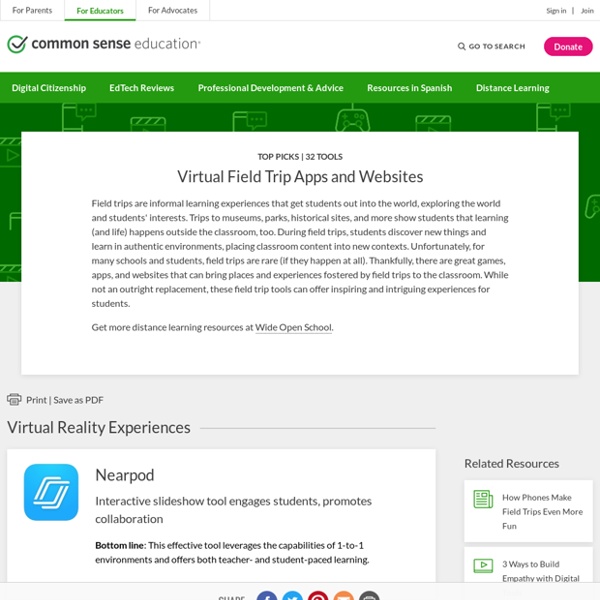



https://www.commonsense.org/education/top-picks/virtual-field-trip-apps-and-websites
Related: Virtual Fieldtrips • Miscellaneous • VR - VIRTUAL REALITY & AUGMENTED REALITY • free ed websites • British counsel20 Uses For Virtual Worlds In The Classroom Editor’s Note: This is part two of Using Virtual Worlds to educate. You can find part 1 here. You probably never thought you could attend a virtual lecture, discussion, exam, or lab in 3D. The Google Search FAQ: How to Find Anything and Everything It seems that everyone Googles these days. After all, it is a top search engine. And with that, Google offers some enhanced search features that can be very helpful in finding what you need easier and faster. Here are a few basic and not-so-basic ways that you can use those extra Google Search features. Performing a search on Google is pretty straightforward. 4 Ways to Use Augmented and Virtual Reality Apps in the Classroom Are you curious about using augmented or virtual reality in your classroom? If you've already tried it out, are you looking for more app and lesson plan ideas? Either way, we've got you covered. Start with the Google Cardboard headset (it's only $15), and whether you're using iOS, Android, Chromebooks, or iPads, we've curated an assortment of apps and lesson plans to try out with your students. Keep in mind there are ongoing debates around using virtual reality with kids. Skeptics argue that VR experiences can't create genuine empathy, that VR simulations make females sick at higher rates than males, and that ethical considerations -- from psychological implications to privacy concerns -- are urgent issues.
COVID-19 - South Dakota State Library Services - LibGuides at South Dakota State Library Fair Use During COVID-19 Pandemic Ready-to-go Read Alouds Scholastic Book Flix - for Pre-K thru 3rd grade or so. Highly engaging literacy-based read-aloud experience for young children learning to read. The thematically-aligned fiction and nonfiction pairs help children grow their oral vocabulary while providing academic and content vocabulary in context.
How to Make the Most of Virtual Field Trips This how-to article accompanies the feature "Internet Explorers: Virtual Field Trips Are More Than Just Money Savers." How do you keep virtual field trips from becoming the modern-day version of the filmstrip -- something students just passively watch? A few tips from the pros: Will Virtual Reality Drive Deeper Learning? Though no hard numbers are available yet on how many K–12 classrooms are using virtual or augmented reality, new estimates suggest the technology could reach 15 million students by 2025. But without research to show the impact, experiences like landing on the moon or the sinking of the Titanic could be closer to entertainment than education, argue critics, who say much of what’s being marketed as virtual reality is not groundbreaking—or even new. Computer scientists first began experimenting with “virtual experiences” in the 1950s, and by the 1980s goggles and gloves had been developed to simulate immersion in a virtual world. “My question is always: How is virtual reality different from educational film?” asks Audrey Watters, who speaks extensively on the role of technology in education and writes the blog Hack Education.
The History of Kobe Beef in Japan Eating meat from four legged animals was prohibited in Japan for more than a thousand years prior to 1868. This ban was especially strict during the Edo Period (1603-1867). Buddhist influences were primarily responsible for this dietary restriction, but other cultural factors and the need to protect draught animals in times of famine may have reinforced the taboo. After the Meiji Restoration in 1868, the new leaders of Japan wanted, among other things, to reduce traditional social barriers and to encourage the adoption of beneficial Western habits.
What the Research Says About VR in Classrooms While we've been inundated over the past few years with the promises and potentials of virtual reality (VR), it's been tough to slice through the hype to find facts, especially the kind of trustworthy research on VR adoption, effects, and learning potential educators need. Our new Common Sense research report, Virtual Reality 101: What You Need to Know About Kids and VR, helps bring some clarity by summarizing the existing body of studies. First things first, VR has yet to be widely adopted. Only 21% of households have a headset and one can assume this percentage is far lower for classrooms.
How to Find Great Learning Resources for Your Students During School Closures From using video to project-based learning, get recommendations on the best tools for virtual learning. Schools across the United States and the world are closing due to the coronavirus pandemic and the urgent need for social distancing. This leaves teachers and schools scrambling to figure out how to keep kids learning at home during this time. Whether you're used to teaching with tech or not, transitioning to virtual learning is a big undertaking.
Covid-19 support for parents The LearnEnglish Kids team want to support parents at this challenging time. Many parents around the world are spending a lot of time at home with their young children. If you're in this situation, our website can help you support your child's English learning at home. Here are some ideas for short activities that your children can do by themselves and/or with limited guidance. The Educational Potential of Augmented Reality I’m not sure about you, but watching my neighborhood—OK, the entire world—become obsessed with the augmented reality (AR) game Pokémon Go, I knew I had better do some serious research into AR’s implications and applications. Virtual vs. augmented Sportvision